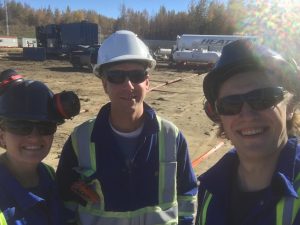FlareNet Team Makes its First-Ever Measurements During a Flare Flowback Event in Canada

This past summer the FlareNet Network worked with its Board of Directors and industry partners to facilitate site access for field measurements in Canada. As a result, FlareNet researchers have just returned from its first-ever dedicated field measurement campaign during a flowback event at a well site in Alberta. The team successfully collected sky-LOSA image data as well as flare gas sample and flowrate data. This information will be used to calculate black carbon emission rates for flares and conditions typical of Canadian operations, and is a key first step toward developing improved emission factors for use in Canadian reporting.
Sky-LOSA (Line-Of-Sight Attenuation using sky-light), is a FlareNet developed technology that enables remote optical measurement of soot concentration (black carbon) and emission rates in flare plumes. With previous support of from World Bank Global Gas Flaring Reduction (GGFR), sky-LOSA has been successfully deployed in Uzbekistan, Ecuador, and Mexico, and, as of earlier this month, Alberta, Canada.
FlareNet sent some of its most experienced researchers into the field for this important first campaign – Project Engineer Melina Jefferson, and PhD candidates Joshua Armitage and Bradley Conrad.  Continued site access will be essential to completing field measurements on a statistically significant number of flares. FlareNet is especially grateful for the strong leadership of its Board of Directors and industry partners for making these first measurements a success. This support and engagement is vital to achieving FlareNet’s research mandate to provide quantitative data, models, and measurement techniques for flare generated pollutant emissions, as part of enabling science-based regulations, accurate pollutant inventories, and engineered mitigation strategies to minimize environmental impacts in the energy sector.
Continued site access will be essential to completing field measurements on a statistically significant number of flares. FlareNet is especially grateful for the strong leadership of its Board of Directors and industry partners for making these first measurements a success. This support and engagement is vital to achieving FlareNet’s research mandate to provide quantitative data, models, and measurement techniques for flare generated pollutant emissions, as part of enabling science-based regulations, accurate pollutant inventories, and engineered mitigation strategies to minimize environmental impacts in the energy sector.


March 20, 2024 at 12:04 am
Wow, awesome weblog layout! How long have you ever been running a blog for?
you make running a blog look easy. The total glance
of your web site is great, as well as the content! You can see similar here sklep online
March 21, 2024 at 7:50 pm
Wow, marvelous blog structure! How long have you been running a blog for?
you make blogging glance easy. The overall look of
your site is excellent, as smartly as the content material!
You can see similar here sklep
March 22, 2024 at 5:35 pm
Wow, superb blog format! How lengthy have you been blogging for?
you make running a blog glance easy. The total look
of your website is great, let alone the content! You can see similar here dobry sklep
March 27, 2024 at 6:57 pm
Howdy! Do you know if they make any plugins to help with SEO?
I’m trying to get my blog to rank for some targeted keywords but I’m not seeing very good results.
If you know of any please share. Cheers! You can read similar text here: Sklep online
March 29, 2024 at 9:41 pm
Hi! Do you know if they make any plugins to assist with SEO?
I’m trying to get my blog to rank for some targeted keywords but I’m not seeing
very good success. If you know of any please share. Cheers!
You can read similar article here: Ecommerce
April 3, 2024 at 6:19 pm
Hello there! Do you know if they make any plugins to assist with Search Engine Optimization? I’m trying
to get my website to rank for some targeted keywords but
I’m not seeing very good gains. If you know of any please share.
Cheers! You can read similar blog here: Backlink Building
April 3, 2024 at 10:51 pm
Hello there! Do you know if they make any plugins to assist
with SEO? I’m trying to get my site to rank for some targeted
keywords but I’m not seeing very good results.
If you know of any please share. Cheers! You can read similar
art here: AA List
April 15, 2024 at 5:03 pm
Wow, wonderful blog format! How lengthy have you been blogging for?
you made blogging look easy. The overall look of your web site is wonderful, as smartly as the content!
You can see similar here sklep online
April 16, 2024 at 8:08 pm
tadalafil 5 mg tablet price